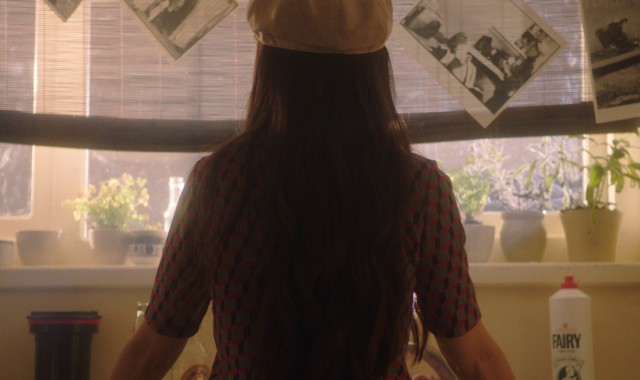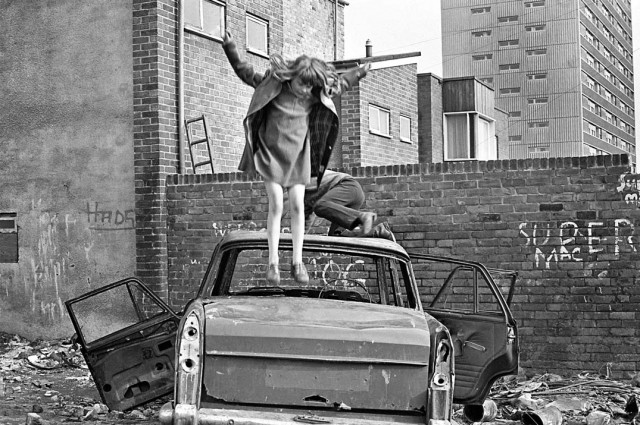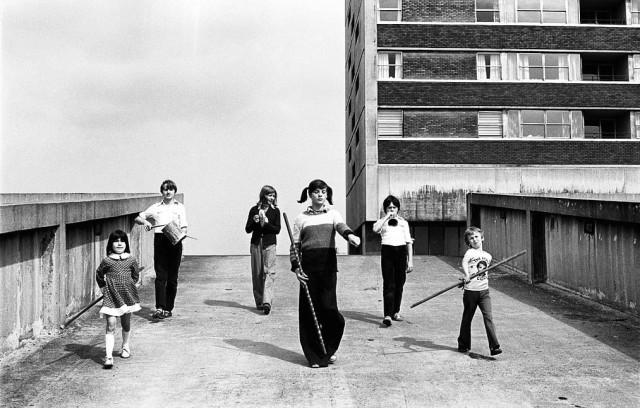The Big Interview:
Tish Producer Jen Corcoran

“Tish’s work was driven by her compassion and her feeling of injustice.” Jennifer Jasmine White speaks with Tish producer, Jen Corcoran…
In one of the most powerful moments from Paul Sng’s new documentary Tish, the CV is rendered a tragic form. Throughout the film, Maxine Peake has sharply narrated Tish Murtha’s eloquent expressions of political consciousness, but towards its end, we are privy to her rehearsal of the pointedly generic clichés of a curriculum vitae. Murtha lists her skills and experience, hoping to find the hospitality job she desperately needs to make ends meet. Though her work is now celebrated by institutions such as Tate, little such recognition was given during her lifetime. At the end of her life, she desperately sought low-paid employment as a means to be able to stay warm and fed. All too often, this is the decisively unromantic fate of the working-class artist.
Murtha notes her ability to function well in a team, as well as on her own initiative. These are lines familiar to most of us, and indeed have most likely parroted ourselves. Their impact is in their spirit crushing banality and empty universality. Then comes the final line: “along with reading, and walking to keep fit, I am a keen photographer, and enjoy developing my own photographs.” Murtha’s career-long commitment to the political possibilities of the photographic form is reduced to the brief mention of a casual hobby. What’s worse, its inclusion in this context seems only a means of stressing a blankly marketable personal ‘well-roundedness’. This is the only use for Murtha’s years of experience within the punitive employment market of austerity Britain. The reading of the CV is one quietly tragic moment in a film of many.
Tish charts the life of documentary photographer Tish Murtha (1956-2013), a woefully underappreciated talent from the North-East. Murtha recorded the comedy, poverty, and ambiguity of working-class experience in an increasingly post-industrial Britain, and unlike several of her more renowned contemporaries, that experience was decisively her own. As one of those contemporaries, Chris Killip, puts it in the film, “Tish was committed to working-class struggle, which is continuous and never ending.”
To see her photos is to begin to glimpse the affective power of community, to understand the pernicious impacts of Britain’s ruling classes, and to see the baldly political potential of photography as a form. To see Tish is to extend that potential to documentary. Hers was a life driven by commitment, and this film replicates that drive. As often in Murtha’s photographs themselves, Tish renders supposedly ‘ordinary’ facets of life newly visible and newly powerful. Among many other things, this is a film about the hidden cruelties that facilitate structural inequality. To reveal them, as Murtha did, is a necessary prerequisite to change.
In Tish, Paul Sng, Ella Murtha and Jen Corcoran have created a masterful piece of documentary filmmaking. It is a piece that performs important recovery work, reinserting Murtha into narratives of British social realism, documentary photography, and understandings of working-class culture much more broadly. Yet perhaps the great joy of the film is the surprises contains. It is, for instance, a deeply emotive exploration of motherhood, both on the part of Murtha’s daughter, Ella, and director Sng. Through it, the mother-child relationship is rendered both political and tender. Much as the film contributes to mainstream working-class narratives, it also posits challenges.
Murtha’s life is not exclusively ‘gritty’ (whatever that really means), but is filled with jazz, opera, and laughter. Her work not only captured something of the council estate and the factory, but also the intricacies of the sex industry, and the importance of race to analyses of class. Her story is not one of disenfranchisement or ignorance, but of complex ideological engagement, and an unwavering commitment to precise articulations. Depictions of working-class experience as multiple and contradictory remain frustratingly rare, but the work of Murtha, and indeed now Sng, are two vital contributions.
Throughout, it seemed that Murtha herself was deeply wary of those that would romanticise or soften her documentary work, and of the power of descriptors like ‘artistic’ to do just that. That suspicion is, for instance, partly evidenced through references to lengthy disputes with Newcastle’s Side Gallery. For Murtha, those at Side (namely its owners, Amber Collective) focused too much on the apparent beauty of poverty, and in doing so shared too much with the ‘middle-class trendies’ and ‘community photographers’ that would seek to exploit working-class communities for their own gain. To describe Amber’s work thus is far from uncontroversial, indeed their own legacy is to my mind vital, but such disputes are a necessary reminder that working-class cultural production is in no way homogenous.

Far from united by naïve nostalgia or blind solidarity, questions of categorisation and positionality remain live and complex issues. To find Murtha’s work on the wall of the Tate is wonderful, but it is also a meeting full of mixed feelings, of contradictory desires and institutional connotations. Are Murtha’s works artistic? What does it mean to describe them as such? More remains to be said about the negotiations such a categorisation involves, and yet to understand art as that which moves and challenges its viewer must be to understand Murtha’s works as undeniably, that.
If you don’t leave the cinema feeling inspired, saddened, and furiously pissed off, you’ve not been paying attention.
Ahead of a recent panel discussion with Open Eye Gallery and Emma Case, at Picturehouse at FACT, I spoke with producer Jen Corcoran about the film.
Jennifer Jasmine White: Hi Jen! First, I wanted to ask: what made you want to produce this film?
Jen Corcoran: When Paul and Ella approached me about producing Tish, I had recently moved back to the northeast to establish my company, Freya Films. Part of the motivation behind this was to produce work that I felt passionate about and to champion new narratives from the northeast, in contrast to recent damaging and reductive representations on screen. I felt a personal connection to Tish’s story and knew her experiences had a vital contemporary relevance.
What do you think the expectations are for working-class creatives in Britain? How do you think Tish Murtha’s work and legacy slots into or challenges those expectations?
The greatest expectation placed upon working-class creatives is the assumption that access to culture is equal or that all individuals can operate within the unchallenged economics of the creative industries. This includes expectations that creatives can work for free during multiple development phases, fund travel to interviews, meetings or festivals where their work is shown, or access necessary training and equipment to progress their careers.
Despite her considerable talent, Tish struggled to access the funds for the necessary tools of her trade (film, chemicals) and was unable to make a living as an artist. It is for this very reason that more privileged voices end up dominating the cultural narrative – they can afford to do so.

There’s a great line in the film where Tish talks about her frustration with ‘middle class trendies’, and Tish seems to have been deeply wary of what we now think of as ‘poverty porn’ or overly voyeuristic work. I wonder if you’ve found those questions to be an ongoing area of tension in the production and marketing of the film?
Rather than making the film for a particular market, our primary goal was to make a film that established Tish’s legacy within the canon of British documentary photographers and addressed the treatment of working-class art and working-class communities in Britain over recent decades.
Our first responsibility was to Tish’s family and to her memory, and we wanted to make a film with compassion and care that reflected our own principles as filmmakers. For this reason, we chose a non-commercial route to the screen, which arguably limited the budget and provided challenges to production but gave us greater control and ensured that we could work ethically and with full empathy.
One of the things I loved most about this film are that it presents Tish as someone with a huge amount of agency, at the same time as her life was so tragically directed by forces beyond her control. What do you see as the value of presenting a working-class woman and artist in that way?
There is certainly a fair amount of cliché in working-class representation on screen. It’s important that a multiplicity of narratives about working-class lives are supported and made visible, told truthfully and with nuance. Tish’s story reflects one singular experience, but our hope is that through telling it we were able to communicate a wider message about the value of working-class lives.
Another vital facet seemed to be the depth of culture that seemed to be swirling around in the background. For instance, her love for music, and it’s importance to both her life and to the documentary. I wonder if you could say a little bit more about its impact on the film?
We know that Tish adored jazz and inherited a love of opera from her mother who supported Tish’s artistic ambitions in her early life. Aside from composer Alexandra Hamilton-Ayres’ fantastic score, we only wanted to use music in the film that Tish herself would have enjoyed. Representations of British working-class life (particularly in the 70s and 80s) often draw from the anarcho-punk popular at the time, so we were glad to offer an alternative representation.
It’s important to note the twofold nature of the barriers that Tish faced, not only as working-class, but as a working-class woman. I feel as though in much of Tish’s work that question of gendered experience is central, from her portraits of the sex industry to her work on often intensely masculine labour movements. How important do you think gender is to Tish’s work?
Speaking purely from my own perspective – I believe that Tish’s gender probably granted her access to communities that she may not have been able to access otherwise, or changed how she was perceived within that community. For better or worse I believe women are treated as a less threatening presence, which may have impacted how she was received by (for example) the all-male factory workers of Scotswood Road.
Tish’s work always prioritised collaboration over voyeurism and her pictures of Soho nightlife were co-authored with the community – the text that accompanied the series was written by Karen, one of the dancers depicted, and the images reflect the power and agency of their subjects.

I’m interested in Tish’s later imagined project which was, as the film shows, rejected for funding by Arts Council England. Do you feel that rejection seems to speak to the way in which Tish’s work is, even now, sometimes celebrated as historical account, rather than that which speaks to urgent and contemporary questions?
Critics and curators are often backed by institutions with agendas or responsibilities that cannot or will not make space for contemporary questions to come to the forefront. I do believe it is true that historical subjects are perceived as less politically threatening – but are often accompanied by an apology.
Lastly, one of my favourite moments in the film is when Ella poses a question to a friend of Tish’s: “how did Tish make you feel?” I think it’s a really quietly powerful question, so I wanted to ask: how important do you think feeling is to the politics of Tish’s work? How important is it to this film?
Tish’s work was driven by her compassion and her feeling of injustice. Ella’s work is driven by her love for her mother and the feeling that her unique perspective deserved to be recognised. Our work was driven by our love for the communities we grew up among and our own political anger. We knew we’d done our job as filmmakers when all of that was present in the film.
Jennifer Jasmine White
Images, from top: Tish film still; SuperMac, Elswick Kids (1978) – Tish Murtha © Ella Murtha, all rights reserved; Kids Jumping On To Mattresses – Youth Unemployment (1981) Tish Murtha © Ella Murtha, all rights reserved; Kenilworth Road Kids, Cruddas Park, Juvenile Jazz Bands (1979) – Tish Murtha © Ella Murtha, all rights reserved.





